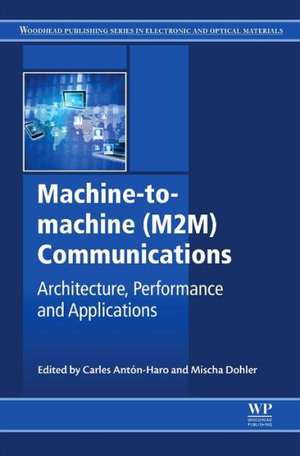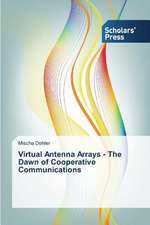Machine-to-machine (M2M) Communications: Architecture, Performance and Applications: Woodhead Publishing Series in Electronic and Optical Materials
Editat de Carles Anton-Haro, Mischa Dohleren Limba Engleză Hardback – 11 ian 2015
Machine-to-machine communications refers to autonomous communication between devices or machines. This book serves as a key resource in M2M, which is set to grow significantly and is expected to generate a huge amount of additional data traffic and new revenue streams, underpinning key areas of the economy such as the smart grid, networked homes, healthcare and transportation.
- Examines the opportunities in M2M for businesses
- Analyses the optimisation and development of M2M communications
- Chapters cover aspects of access, scheduling, mobility and security protocols within M2M communications
Din seria Woodhead Publishing Series in Electronic and Optical Materials
- 24%
 Preț: 1160.66 lei
Preț: 1160.66 lei - 9%
 Preț: 912.54 lei
Preț: 912.54 lei - 39%
 Preț: 1136.44 lei
Preț: 1136.44 lei - 9%
 Preț: 956.68 lei
Preț: 956.68 lei - 24%
 Preț: 951.04 lei
Preț: 951.04 lei - 9%
 Preț: 1335.64 lei
Preț: 1335.64 lei - 29%
 Preț: 986.78 lei
Preț: 986.78 lei - 24%
 Preț: 874.56 lei
Preț: 874.56 lei - 29%
 Preț: 1414.77 lei
Preț: 1414.77 lei - 29%
 Preț: 1075.95 lei
Preț: 1075.95 lei - 9%
 Preț: 1216.61 lei
Preț: 1216.61 lei - 39%
 Preț: 811.62 lei
Preț: 811.62 lei - 29%
 Preț: 1193.77 lei
Preț: 1193.77 lei - 9%
 Preț: 1444.32 lei
Preț: 1444.32 lei - 24%
 Preț: 926.89 lei
Preț: 926.89 lei - 9%
 Preț: 1107.16 lei
Preț: 1107.16 lei - 9%
 Preț: 1262.45 lei
Preț: 1262.45 lei - 9%
 Preț: 954.69 lei
Preț: 954.69 lei - 9%
 Preț: 1006.73 lei
Preț: 1006.73 lei - 9%
 Preț: 958.65 lei
Preț: 958.65 lei - 9%
 Preț: 948.72 lei
Preț: 948.72 lei - 9%
 Preț: 1150.61 lei
Preț: 1150.61 lei - 23%
 Preț: 1493.72 lei
Preț: 1493.72 lei - 9%
 Preț: 950.94 lei
Preț: 950.94 lei - 29%
 Preț: 1333.73 lei
Preț: 1333.73 lei - 9%
 Preț: 901.22 lei
Preț: 901.22 lei - 9%
 Preț: 1130.18 lei
Preț: 1130.18 lei - 9%
 Preț: 1049.49 lei
Preț: 1049.49 lei - 24%
 Preț: 871.12 lei
Preț: 871.12 lei - 27%
 Preț: 1459.23 lei
Preț: 1459.23 lei - 20%
 Preț: 1071.49 lei
Preț: 1071.49 lei - 24%
 Preț: 932.11 lei
Preț: 932.11 lei - 29%
 Preț: 1071.64 lei
Preț: 1071.64 lei - 24%
 Preț: 670.36 lei
Preț: 670.36 lei - 9%
 Preț: 926.48 lei
Preț: 926.48 lei - 23%
 Preț: 929.43 lei
Preț: 929.43 lei - 9%
 Preț: 897.50 lei
Preț: 897.50 lei - 9%
 Preț: 1276.81 lei
Preț: 1276.81 lei - 9%
 Preț: 957.63 lei
Preț: 957.63 lei - 29%
 Preț: 845.10 lei
Preț: 845.10 lei - 9%
 Preț: 953.05 lei
Preț: 953.05 lei - 33%
 Preț: 1126.67 lei
Preț: 1126.67 lei - 29%
 Preț: 954.77 lei
Preț: 954.77 lei - 24%
 Preț: 961.16 lei
Preț: 961.16 lei - 23%
 Preț: 930.29 lei
Preț: 930.29 lei - 23%
 Preț: 1080.19 lei
Preț: 1080.19 lei - 9%
 Preț: 1454.84 lei
Preț: 1454.84 lei
Preț: 1276.29 lei
Preț vechi: 1672.98 lei
-24% Nou
Puncte Express: 1914
Preț estimativ în valută:
244.33€ • 254.94$ • 204.81£
244.33€ • 254.94$ • 204.81£
Carte tipărită la comandă
Livrare economică 06-20 martie
Preluare comenzi: 021 569.72.76
Specificații
ISBN-13: 9781782421023
ISBN-10: 1782421025
Pagini: 426
Dimensiuni: 152 x 229 x 32 mm
Editura: ELSEVIER SCIENCE
Seria Woodhead Publishing Series in Electronic and Optical Materials
ISBN-10: 1782421025
Pagini: 426
Dimensiuni: 152 x 229 x 32 mm
Editura: ELSEVIER SCIENCE
Seria Woodhead Publishing Series in Electronic and Optical Materials
Public țintă
Postgraduate students and academic researchers in electronics, computer engineering, telecommunications and networking. R&D managers in industrial sectors such as wireless technology, electronics, cellular communications, networking, and information technology.Cuprins
- List of contributors
- Woodhead Publishing Series in Electronic and Optical Materials
- 1: Introduction to machine-to-machine (M2M) communications
- Abstract
- Acknowledgment
- 1.1 Introducing machine-to-machine
- 1.2 The machine-to-machine market opportunity
- 1.3 Examples of commercial and experimental M2M network rollouts
- 1.4 Machine-to-machine standards and initiatives
- 1.5 Book rationale and overview
- Part One: Architectures and standards
- 2: Overview of ETSI machine-to-machine and oneM2M architectures
- Abstract
- 2.1 Introduction
- 2.2 Need and rationale for M2M standards
- 2.3 Standardized M2M architecture
- 2.4 Using M2M standards for “vertical domains, the example of the smart home
- 2.5 Conclusions and future trends for M2M standardization
- 3: Overview of 3GPP machine-type communication standardization
- Abstract
- 3.1 Introduction
- 3.2 Pros and cons of M2M over cellular
- 3.3 MTC standardization in 3GPP
- 3.4 Concluding remarks
- 4: Lower-power wireless mesh networks for machine-to-machine communications using the IEEE802.15.4 standard
- Abstract
- Acknowledgments
- 4.1 Introduction
- 4.2 The origins
- 4.3 Challenges of low-power mesh networking
- 4.4 The past
- 4.5 The present
- 4.6 The future
- 4.7 Conclusion
- 5: M2M interworking technologies and underlying market considerations
- Abstract
- 5.1 Interworking technologies for M2M communication networks: introduction
- 5.2 A panorama of heterogeneous technologies
- 5.3 From capillary to IP networks
- 5.4 Going up to the M2M cloud
- 5.5 M2M market as internetworking enabler
- 5.6 Future trends
- 6: Weightless machine-to-machine (M2M) wireless technology using TV white space: developing a standard
- Abstract
- 6.1 Why a new standard is needed
- 6.2 The need for spectrum
- 6.3 TV white space as a solution
- 6.4 Designing a new technology to fit M2M and white space
- 6.5 Weightless: the standard designed for M2M in shared spectrum
- 6.6 Establishing a standards body
- 6.7 Conclusions
- 7: Supporting machine-to-machine communications in long-term evolution networks
- Abstract
- Acknowledgments
- 7.1 Introduction to M2M in LTE
- 7.2 Main technical challenges and existing solutions
- 7.3 Integrating MTC traffic into a human-centric system: a techno-economic perspective
- 7.4 Business implications for MTC in LTE
- 7.5 Conclusions
- 2: Overview of ETSI machine-to-machine and oneM2M architectures
- Part Two: Access, scheduling, mobility and security protocols
- 8: Traffic models for machine-to-machine (M2M) communications: types and applications
- Abstract
- 8.1 Introduction
- 8.2 Generic methodology for traffic modeling
- 8.3 M2M traffic modeling
- 8.4 Model fitting from recorded traffic
- 8.5 Conclusions
- 9: Random access procedures and radio access network (RAN) overload control in standard and advanced long-term evolution (LTE and LTE-A) networks
- Abstract
- Acknowledgments
- 9.1 Introduction
- 9.2 E-UTRAN access reservation protocol
- 9.3 Extended access barring protocol
- 9.4 Alternative E-UTRAN load control principles
- 9.5 Overview of core network challenges and solutions for load control
- 9.6 Ongoing 3GPP work on load control
- 9.7 Resilience to overload through protocol re-engineering
- 9.8 Conclusion
- 10: Packet scheduling strategies for machine-to-machine (M2M) communications over long-term evolution (LTE) cellular networks
- Abstract
- 10.1 State of the art in M2M multiple access in legacy cellular systems
- 10.2 Signaling and scheduling limitations for M2M over LTE
- 10.3 Existing approaches for M2M scheduling over LTE
- 10.4 Novel approaches for M2M scheduling over LTE
- 10.5 Technology innovations and challenges for M2M scheduling over wireless networks beyond 2020
- 10.6 Conclusions
- 11: Mobility management for machine-to-machine (M2M) communications
- Abstract
- Acknowledgments
- 11.1 Introduction
- 11.2 Use cases for M2M mobility
- 11.3 Challenges of M2M mobility
- 11.4 Infrastructure considerations for mobility in M2M
- 11.5 State-of-the-art solutions
- 11.6 Summary and conclusions
- 12: Advanced security taxonomy for machine-to-machine (M2M) communications in 5G capillary networks
- Abstract
- 12.1 Introduction
- 12.2 System architecture
- 12.3 System assets
- 12.4 Security threats
- 12.5 Types of attacks
- 12.6 Layers under attack
- 12.7 Security services
- 12.8 Security protocols and algorithms
- 12.9 Concluding remarks
- 13: Establishing security in machine-to-machine (M2M) communication devices and services
- Abstract
- 13.1 Introduction
- 13.2 Requirements and constraints for establishing security in M2M communications
- 13.3 Trust models in M2M ecosystems
- 13.4 Protecting credentials through their lifetime in M2M systems
- 13.5 Security bootstrap in the M2M system
- 13.6 Bridging M2M security to the last mile: from WAN to LAN
- 13.7 Conclusion
- 8: Traffic models for machine-to-machine (M2M) communications: types and applications
- Part Three: Network optimization for M2M communications
- 14: Group-based optimization of large groups of devices in machine-to-machine (M2M) communications networks
- Abstract
- 14.1 Introduction
- 14.2 Mobile network optimizations for groups of M2M devices
- 14.3 Managing large groups of M2M subscriptions
- 14.4 Group-based messaging
- 14.5 Policy control for groups of M2M devices
- 14.6 Groups and group identifiers
- 14.7 Conclusions
- 15: Optimizing power saving in cellular networks for machine-to-machine (M2M) communications
- Abstract
- 15.1 Introduction
- 15.2 Extended idle mode for M2M devices
- 15.3 Paging idle-mode M2M device in a power-efficient manner
- 15.4 Power saving for uplink data transmission
- 15.5 Conclusions
- 16: Increasing power efficiency in long-term evolution (LTE) networks for machine-to-machine (M2M) communications
- Abstract
- 16.1 Introduction
- 16.2 M2M scenarios
- 16.3 3GPP status and work
- 16.4 Introduction to basic LTE procedures
- 16.5 UE power consumption in LTE
- 16.6 Discussion and conclusion
- 17: Energy and delay performance of machine-type communications (MTC) in long-term evolution-advanced (LTE-A)
- Abstract
- 17.1 Introduction
- 17.2 Technology background
- 17.3 Analytic performance assessment
- 17.4 Performance assessment via simulation
- 17.5 Numerical results
- 17.6 Conclusion and further research directions
- Appendix
- 14: Group-based optimization of large groups of devices in machine-to-machine (M2M) communications networks
- Part Four: Business models and applications
- 18: Business models for machine-to-machine (M2M) communications
- Abstract
- 18.1 Introduction
- 18.2 An overview of M2M from a commercial perspective
- 18.3 A brief history of M2M
- 18.4 The potential for M2M
- 18.5 The benefits of M2M
- 18.6 Business models for M2M
- 18.7 The return on investment
- 19: Machine-to-machine (M2M) communications for smart cities
- Abstract
- 19.1 Introduction
- 19.2 Smart city technologies
- 19.3 M2M smart city platform
- 19.4 Financing M2M deployments in smart cities
- 19.5 The ten smart city challenges
- 19.6 Conclusions
- 20: Machine-to-machine (M2M) communications for e-health applications
- Abstract
- Acknowledgments
- 20.1 Introduction
- 20.2 M2M network architecture
- 20.3 Enabling wireless technologies: standards and proprietary solutions
- 20.4 End-to-end solutions for M2M communication: connectivity and security
- 20.5 Existing projects
- 20.6 Concluding remarks
- 18: Business models for machine-to-machine (M2M) communications
- Index





